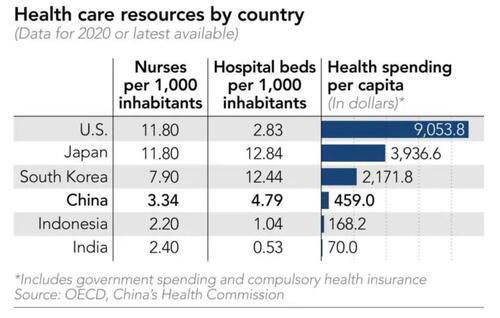President Xi Faces An Impossible Dilemma In Shanghai As COVID Outbreak Worsens Despite Lockdown
In the span of just over a week, CCP authorities have gone from denying plans for a citywide lockdown of Shanghai to announcing what was supposed to be a two-part staggered lockdown – to simply locking down the entire city and sending in the military and a contingent of medical workers as locals accuse the government of violating its social compact to put the people’s interests first.
Now, as the entire city of roughly 26 million faces what’s already shaping up to be the most punishing lockdown in China since the original three-month Wuhan lockdown nightmare, Nikkei reports that Beijing has found itself in an incredibly difficult position.
On Sunday, Shanghai counted 9,006 mainly asymptomatic infections, more than two-thirds of the national tally.
The reason the situation in Shanghai presents such a difficult conundrum is that backing down from its lockdown in Shanghai would mean admitting that the “Zero COVID” approach has been an abject failure.
But continuing with the heavy-handed lockdown risks spurring even more unrest – something the CCP has bent over backwards to avoid. For the CCP, it’s an impossible dilemma.
Already, social media has been flooded with reports of locals dying from neglect as hospital resources have been stretched thin (and not from COVID; it’s other ailments that are killing people now).
While the entire city has been locked down for less than a week, many individual residential compounds have been locked down for much longer – some since mid-March.
“It is so uncharacteristic of Shanghai to have to go through this,” said Zhong Lei, a teacher in the city, whose residential compound was locked down even earlier, in mid-March.
On Tuesday, authorities reiterated that they must try to keep the city’s port and its factories running at full capacity. But accomplishing this – as we have already reported – will require even more draconian measures like forcing workers to essentially live inside the city’s factories.
Here’s a rundown of some of the obstacles that have led to the surge in cases and deaths, which local authorities have been accused of obscuring and underreporting.
- Experts are divided over what those costs are. Some warn of heavy economic losses, while others suggest the strict measures ensure industrial stability, not to mention saving lives. Likewise, there is division over China’s vaccination program. Authorities say nearly 90% of the population of 1.4 billion has been inoculated, a staggering feat by any measure. Yet the rate among the most vulnerable seniors lags behind, and China continues to insist on using homegrown shots despite questions over efficacy.
- What seems evident is that there is no clear path for China to join the growing number of countries “living with COVID” anytime soon, which presents profound risks to China’s economy, as well as its status in global trade.
- “If we stop all containment measures now, it means all the previous efforts are for nothing,” Liang Wannian, a top official at the National Health Commission, said in late March in response to a reporter’s query on why China is not shifting toward treating COVID as endemic, like influenza.
- “The recent fine-tuning is an indication that the country is experimenting with a less costly – and thus more sustainable – zero-COVID approach,” Xu Tianchen, a China economist at The Economist Intelligence Unit, told Nikkei Asia.
Nikkei added that despite China’s efforts to reform and build up its health care infrastructure over the past decade, the country still faces capacity limitations. The latest available data shows the country had 3.34 registered nurses per 1,000 people, compared to 11.8 in the US. China’s health spending per capita was $459 in 2018, while US spending came to $9,054 in 2019.
Another major issue, as we mentioned above, is the low vaccination rates among seniors.
But it’s not just seniors who are vulnerable. China’s refusal to approve western vaccines in favor of its home-brewed concoctions has hurt immunity levels in the broader population. One UK health data provider in the UK estimated in March that due to the lower efficacy of China’s vaccines, less than 30% of the population is protected from infection. “Should infections hit China in the same magnitude as Hong Kong, deaths could exceed 1 million.”
If that happens, China would surpass Hong Kong as the country with the highest contemporary COVID death rate.
Unsurprisingly, economists the world over are bracing for the worst as they increasingly expect the Shanghai lockdown to lop an entire percentage point – or more – off China’s GDP growth.
Tyler Durden
Tue, 04/05/2022 – 22:40
via ZeroHedge News https://ift.tt/vcULgd9 Tyler Durden



